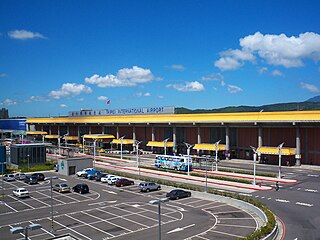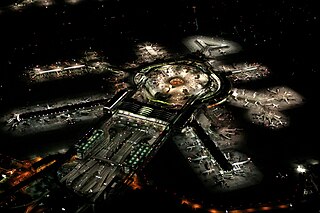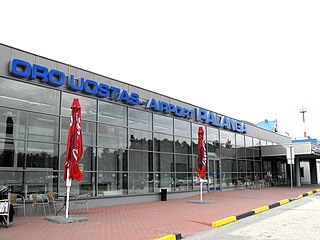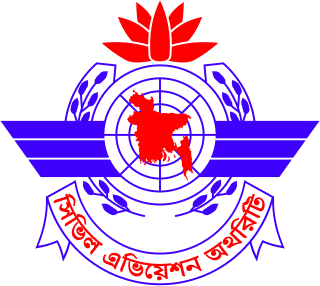
An airline is a company that provides air transport services for traveling passengers and/or freight. Airlines use aircraft to supply these services and may form partnerships or alliances with other airlines for codeshare agreements, in which they both offer and operate the same flight. Generally, airline companies are recognized with an air operating certificate or license issued by a governmental aviation body. Airlines may be scheduled or charter operators.

The International Civil Aviation Organization is a specialized agency of the United Nations that coordinates the principles and techniques of international air navigation, and fosters the planning and development of international air transport to ensure safe and orderly growth. The ICAO headquarters are located in the Quartier international de Montréal of Montreal, Quebec, Canada.

Norfolk International Airport is seven miles (11 km) northeast of downtown Norfolk, an independent city in Virginia, United States. It is owned and operated by the Norfolk Airport Authority: a bureau under the municipal government. The airport serves the Hampton Roads metropolitan area of southeast Virginia as well as northeast North Carolina. Norfolk International currently flies to one destination outside of the United States via Frontier Airlines’ service to San Juan, Puerto Rico.

Gulfport–Biloxi International Airport is a joint civil–military public-use airport three nautical miles (6 km) northeast of the central business district of Gulfport, a city in Harrison County, Mississippi, United States. It is owned by the Gulfport–Biloxi Regional Airport Authority and serves the Gulf Coast area.

Taipei Songshan Airport is a regional airport and military airbase located in Songshan District, Taipei, Taiwan. The airport covers an area of 182 hectares.
The freedoms of the air, also called five freedoms of air transport, are a set of commercial aviation rights granting a country's airlines the privilege to enter and land in another country's airspace. They were formulated as a result of disagreements over the extent of aviation liberalisation in the Convention on International Civil Aviation of 1944, known as the Chicago Convention. The United States had called for a standardized set of separate air rights to be negotiated between states, but most other countries were concerned that the size of the U.S. airlines would dominate air travel if there were not strict rules. The freedoms of the air are the fundamental building blocks of the international commercial aviation route network. The use of the terms "freedom" and "right" confers entitlement to operate international air services only within the scope of the multilateral and bilateral treaties that allow them.

RIX Riga Airport is the international airport of Riga, the capital of Latvia, and the largest airport in the Baltic states with direct flights to 76 destinations as of November 2019. It serves as a hub for airBaltic, SmartLynx Airlines and RAF-Avia, and as one of the base airports for Ryanair. The Latvian national carrier airBaltic is the largest carrier that serves the airport, followed by Ryanair. The airport is located in the Mārupe Municipality west of Riga, approximately 10 km from its city centre.

Murtala Muhammed International Airport (MMIA) is an international airport located in Ikeja, Lagos State, Nigeria, and is the major airport serving the entire state. The airport was initially built during World War II and is named after Murtala Muhammed (1938–1976), the fourth military ruler of Nigeria.

An international airport is an airport with customs and border control facilities enabling passengers to travel between countries around the world. International airports are usually larger than domestic airports, and feature longer runways and have facilities to accommodate heavier aircraft such as the Boeing 747 and the Airbus A380 commonly used for international and intercontinental travel. International airports often host domestic flights, which helps feed both passengers and cargo into international ones.

SITA is a multinational information technology company providing IT and telecommunication services to the air transport industry. The company provides its services to around 400 members and 2,500 customers worldwide, which it claims is about 90% of the world's airline business. Around the world, nearly every passenger flight relies on SITA technology.
Aviation law is the branch of law that concerns flight, air travel, and associated legal and business concerns. Some of its area of concern overlaps that of admiralty law and, in many cases, aviation law is considered a matter of international law due to the nature of air travel. However, the business aspects of airlines and their regulation also fall under aviation law. In the international realm, the International Civil Aviation Organization (ICAO) provides general rules and mediates international concerns to an extent regarding aviation law. The ICAO is a specialized agency of the United Nations.

Palanga International Airport is a regional international airport located near the resort town Palanga at the Baltic Sea. It is the third largest airport in Lithuania and focuses on short and mid-range routes to European destinations. It serves the Lithuanian Baltic sea resorts of Palanga and the city of Klaipėda, and parts of Samogitia and western Latvia.
This is a list of airline codes. The table lists IATA's two-character airline designators, ICAO's three-character airline designators and the airline call signs. Historical assignments are also included.

Puerto Princesa International Airport is an airport serving the general area of Puerto Princesa, located in the province of Palawan in the Philippines. It is classified as an international airport by the Civil Aviation Authority of the Philippines.
In aviation, the flight length or flight distance refers to the distance of a flight. Aircraft do not necessarily follow the great-circle distance, but may opt for a longer route due to weather, traffic, to utilise a jet stream, or to refuel.

Civil Aviation Authority of Bangladesh (CAAB) functions as the regulatory body for all aviation related activities in Bangladesh. It is the civil aviation authority operating under the Ministry of Civil Aviation & Tourism. All nine operational airports are operated by the CAAB. A member of International Civil Aviation Organization, it has signed bilateral air transport agreement with 52 states. It is headquartered in Kurmitola, Dhaka.

Civil aviation is one of two major categories of flying, representing all non-military and non-state aviation, both private and commercial. Most countries in the world are members of the International Civil Aviation Organization and work together to establish common Standards and Recommended Practices for civil aviation through that agency.
Hunting-Clan Air Transport was a wholly private, British independent airline that was founded in the immediate post-World War II period. It began trading on 1 January 1946 as Hunting Air Travel Ltd. It was a subsidiary of the Hunting Group of companies, which had come from the shipping industry and could trace its history back to the 19th century. The newly formed airline's first operating base was at Bovingdon Airport in Southeast England. Its main activities were contract, scheduled and non-scheduled domestic and international air services that were initially operated with Douglas Dakota and Vickers Viking piston airliners from the company's Bovingdon base. A change of name to Hunting Air Transport occurred in 1951. By that time, the airline had emerged as one of the healthiest and most securely financed independent airlines in Britain.
The United States has an extensive air transportation network. In 2013, there were 86 airports in the U.S. that annually handled over 1,000,000 passengers each. The civil airline industry is entirely privately owned and has been largely deregulated since 1978, while most major airports are publicly owned. The three largest airlines in the world by passengers carried are U.S.-based; American Airlines is number one after its 2013 acquisition by US Airways. Of the world's 50 busiest passenger airports, 16 are in the United States, including the top five and the busiest, Hartsfield–Jackson Atlanta International Airport. In terms of cargo, in 2015, eight of the world's thirty busiest airports were in the U.S., including the world's second-busiest, Memphis International Airport, just behind Hong Kong International Airport in Hong Kong. Private aircraft are also used for medical emergencies, government agencies, large businesses, and individuals.

Civil aviation in India, the world's third-largest civil aviation market as of 2020, traces its origin back to 1911, when the first commercial civil aviation flight took off from a polo ground in Allahabad carrying mail across the Yamuna river to Naini.















